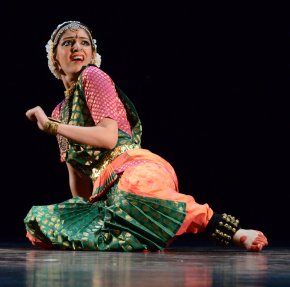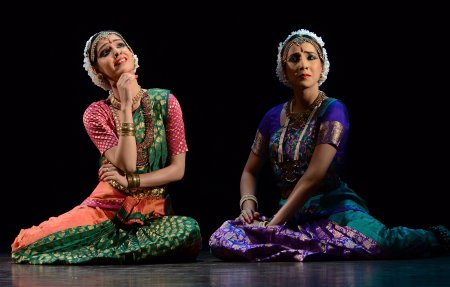
|   |

|   |
Face to Face: A Bharatanatyam dance-theatre dialogue between Draupadi and Sita - Dr. Sunil Kothari e-mail: sunilkothari1933@gmail.com Photos courtesy: Jyotsna Shourie's Dance Centre May 24, 2012 Conceived, choreographed, with script and voice by Bharatanatyam exponent Jyotsna Shourie under the aegis of her Dance Centre in New Delhi, Face To Face, a dialogue between two mythological women from two epics Ramayana and Mahabharata, presented at Chinmaya Mission Auditorium on 19th May 2012 was indeed a novel and interesting presentation in Bharatanatyam technique. Jyotsna is a senior disciple Guru Kalyansundaram Pillai of Rajarajeswari Bharatanatya Kala Mandir, Mumbai. She has been performing from a young age and has won laurels for her various innovative choreographic works aimed at children including Alice in Wonderland, The Birth of Jesus, The Sound of Music, Noddy in Nrityaland and traditional themes like Gita Govindam, The Radha Chalisa, Seasons of Love, The Krishna Chalisa, An Ode to Sri Sai Baba, Coping with Cancer, Tradition and Inspiration, Cosmic Rhythm and Varanasi: A Gateway to Moksha in which she has used film sequences and slides with great effect. Jyotsna mentioned at the beginning of the presentation that she has taken a poetic license and brought together these two powerful women with strong personalities of different ages to dialogue with each other about their plight reflecting the social mores of that age, one in which idealism reigned supreme with Rama as a Purnapuroshottam, in which Sita followed the ideal of a woman who obeyed her husband and suffered a lot. She was not as aggressive in comparison with Draupadi, who was born in an age of karmic times when adharmic, unfair means were employed to gain ends, and those times moulded her character.  Nandita Kalaan in role of Draupadi, frightened at Dusshasan's advances to disrobe her  Nandita Kalaan as Draupadi, Aneesha Grover as Sita Their juxtaposition is indeed fascinating and reveals different facets of women who become victims of their times and they rebel. Both suffer in final analysis and yet as women, they sacrifice every comfort. They sympathize with each other recounting key incidents of their lives. In form of a dance theatre it is a challenging task for a choreographer to weave the different strands and depict the two characters succinctly. Jyotsna has managed it well with a team of dancers, light designer Jaspreet S Uppal, and with brilliant musical support from the renowned musician and singer OS Arun, who with his evocative voice and soulful singing has drawn from various musical traditions lifting the production to an enjoyable height. Credits for voice-overs are given to Aftab Seth and Sharmila Livingston, and for costumes to Dal Chand. The four female dancers included Nandita Kalaan, Aneesha Grover, Ishita Matharu and Supriya Mali. The only male dancer was Abhimanyu Sharma, essentially a theatre actor and impersonated roles of Rama and Ravana. Draupadi’s role was performed by Nandita Kalaan in ‘ekaharya lasyanga’ manner impersonating various characters of Mahabaharata as a solo. The invocatory slokas describing various names of Sita performed by Aneesha Grover; as Janaki, Bhumisuta, Janakanandini, Vaidehi et al were visualized imaginatively by three dancers. Sita’s emergence from Bhumi while ploughing the earth was suggestively depicted. Similarly, Draupadi’s birth from fire with her various epithets was well conceived. With their dialogues and conversation like flashback, the key events were enacted. Rama’s coronation and Manthara’s intervention, Sita listening to Manthara’s provoking Kaikeyi, following Rama to forest and so on, the events unfolded to excellent music. Marriage of Sita with lyrics “Sita Kalyanm, Rama Kalyanam” had haunting melody and the marriage celebrations by four dancers were visualized in interesting manner. Juxtaposing Draupadi’s swayamvara aiming at revolving fish whose reflection in water has to be aimed at and Arjuna’s aiming it successfully, marrying him and going to Hastinapur, when not knowing what Arjuna has brought, Kunti’s order to Arjuna to share her equally with four brothers, Draupadi’s plight, her love for Arjuna and the sequence of her humiliation after she is lost in game of dice, Dusshasana disrobing her, Lord Krishna protecting her were sequences very movingly portrayed in a solo format . Draupadi takes a wow that till her hair is anointed with blood of Dusshasana, she will not tie her hair and maddened by rage, invokes Devi Parashakti. The prayer, the lighting and the expressions left an indelible impression. It was brilliantly choreographed. Further, the three dancers performing together “Ya devi sarva Bhuteshu” was another impressive choreographic piece. Except in case of Ravana kidnapping Sita, lifting her seemed ill placed as Ravana did not even touch her according to Valmiki Ramayana and popular perception, and it struck a discordant note. Sita’s captivity in Ashokavatika, her prayer “Sri Ramachandra kripalu bhaja mana,” Tulasidasa’s Sanskrit prayer was appropriately presented covering the gaps of Rama and Sita’s separation. Hanuman’s arrival with the abhanga like rendering of “Maruti Balavira Ramasevak, Kalyankarak,” burning Lanka, the setubandha and finally Ravana’s death were presented in quick succession. Sita’s agnipravesh, with orange colour scarves as flames, and dancers performing around Sita was visually stunning. Similarly, when Ramapattabhishekam is announced the tillana with four dancers arriving on stage with lamps in their hands, set to Kathanakutuhalam raga, was impressive. Sita’s banishment to forest when she was expecting her sons to Valmiki's ashram was very poignant. And finally she is received by mother earth. Draupadi’s fall while following the Pandavas in Himalayas and her helplessness were enacted with feeling. Invariably it evokes great sympathy for Draupadi. She questions why punishment was meted out to her for what fault of hers? The presentation shuttles between flashbacks of events from Ramayana and Mahabharata. In the finale, Jyotsna arrives on the stage and mentions with hastabhinaya these two women’s eternal enigmatic questions as part of every one of us. One leaves the auditorium pondering about it. Dancers performed with involvement and the flow of narrative was smooth. With excellent musical score as mentioned earlier, the dance theatre dialogue experiment was successful. Dr. Sunil Kothari is dance historian, scholar, author and a renowned dance critic. He is Vice President of World Dance Alliance Asia Pacific India chapter, based in New Delhi. He is a regular contributor to www.narthaki.com, the roving critic for monthly magazine Sruti and is a contributing editor of Nartanam for the past 11 years. Comments He said ... She said! I read Sunilji’s mention of Sita’s abduction in a recent dance review in Narthaki. He has mentioned that Ravana never touched Sita according to Valimiki Ramayana. His comment is not accurate. Valmiki actually paints an entirely different (and graphic) picture. The Adikavi says that Ravana caught hold of Sita by her locks of hair with his left hand and then with his right hand he grasped her thighs. He then took her in his arms and placed her in his chariot before taking off. Tulsidas does not specifically mention how Ravana abducted her – simply that he placed her in his chariot. On the other hand it is Kamban who created that scenario of Ravana lifting Sita along with the land on which she stood without touching her. It might have been the projection of the Tamil sensibilities (regarding chastity and physical purity) inherited by Kamban. And also Kamban, as a devotee, probably could not imagine that such an “evil” fate should befall Sita – that any man other than Rama would have (or could have) touched her and lived to boast about it. To fortify this thought, he adds an additional “secret” about Ravana - that he carried a curse on himself according to which his head would burst to pieces if he ever touched a woman against her wishes. There are so many versions of the Ramayana and it is believed by the faithful that each poet had an inspiring vision of the story as revealed to them through the grace of Lord Rama. Therefore the argument of who is right and what is accurate should be set aside. Myths and stories carry personal meaning for each community that embraces them and render power to their particular beliefs and practices. Epics such as Ramayana have become favorites to people in different communities all over India (and South East Asia) because of such variations that resonated with each community. For eg, Hanuman who is projected as a celibate in India has interesting encounters with a mermaid in the Cambodian Ramayana. Even the mere thought sends scandalous shivers through the spines of Hanuman devotees in India. What is significant to remember is the underlying theme of positive social human behavior of loyalty, love, respect, faithfulness, honesty, courage, compassion fortitude etc. These concepts are phrased in episodes that have as many versions as the Ramayana itself. Therefore, I hope dancers will never fall into a stupor of habitual renditions but continue to add as much color and as many variations to their choreographies of this great epic as well. That would be a true celebration of the Ramayana and a true tribute to Lord Rama – the people’s God! - Ramaa Bharadvaj (May 27, 2012) |